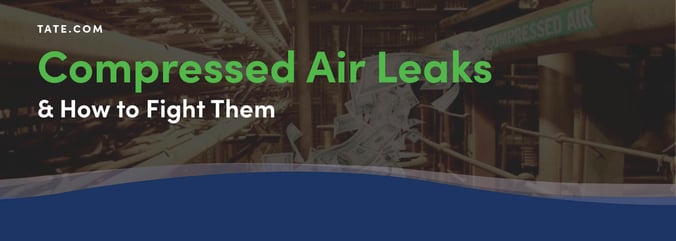
Compressed air leaks may seem like a minor inconvenience, but they can have significant implications for your system’s efficiency and safety. These leaks not only waste energy but can also lead to increased operating costs and potential hazards. In this article, we will explore the dangers of compressed air leaks, how to identify them, quantify the leakage rate, minimize leaks, and find their locations.
Related: Summer Air Compressor Maintenance
Compressed Air Leaks Are Dangerous
Compressed air leaks might appear harmless, but they can pose various risks to your system and operations. Here are some key reasons why compressed air leaks should not be taken lightly:
Energy Loss
Leaks result in a direct loss of compressed air, leading to higher energy consumption and increased utility costs. The wasted energy can have a significant impact on your bottom line.
Decreased System Efficiency
Due to leaks, your compressor will have to work harder to maintain the proper pressure. As a result, your system’s lifespan is shortened, and its overall efficiency is decreased.
Increased Maintenance
Continuous leaking stresses the parts of your system, necessitating more regular maintenance and repairs. Your operations may experience costly downtime and interruptions as a result.
Safety Hazards
Leaks can cause pressure drops in the system, affecting the performance of pneumatic tools and equipment. This can lead to compromised productivity and potential safety hazards for operators.
How to Identify Compressed Air Leaks
Detecting compressed air leaks is crucial for addressing the issue promptly. Here are some common methods used by experts and individuals to identify leaks:
Visual Inspection
Check for any apparent leakage symptoms, such as hissing noises, oil or water droplets, or loose fittings, throughout the complete compressed air system, including the pipes, fittings, valves, and connections.
Ultrasonic Detection
Ultrasonic lead detection is the most versatile form of leak detection. Because of its capabilities, it's readily adapted to a variety of lead detection situations. Utilize ultrasonic leak detectors to identify high-frequency sounds produced by compressed air leaks. These devices can pinpoint the exact location of the leaks, even in noisy environments.
Soap and Water Method
Apply a mixture of soapy water to suspected areas, and observe for bubbles. If bubbles form, it indicates the presence of a leak.
How to Find the Leakage Rate
Understanding the effect of leaks on your system requires identifying and quantifying the leakage rate. Conducting a bleed-down test is one way to measure leakage:
Perform a Bleed-Down Test
Start the compressed air system to the normal operating pressure (P1). Then, turn off the compressor and measure the time (T) it takes for the system to drop to a lower pressure (P2), which should be around half the operating pressure.
Calculate Leak Rate
Use the following formula to calculate the leakage rate in CFM (cubic feet per minute):
Leakage (CFM free air) = [V x (P1-P2)/ (T x 14.7)] x 1.25
- V indicates the total system volume in cubic feet.
- P1 and P2 are pressure readings in PSIG.
- T indicates the time in minutes.
Minimize Compressed Air Leaks
Minimizing compressed air leaks is crucial for improving energy efficiency and reducing operational costs. Here are some strategies to help you tackle this issue:
Establish a Leak Detection Program
Implement regular leak detection and repair programs as part of your maintenance routine. Schedule monthly leak detection tests to identify and address leaks promptly.
Train Employees
Educate your staff about the importance of identifying and reporting compressed air leaks. Encourage them to identify potential leak locations and promptly report any observations proactively.
Use Quality Components
Invest in high-quality pipes, fittings, and seals to reduce the likelihood of leaks. Opt for durable materials that can withstand the operating conditions of your compressed air system.
Finding Leaks
Knowing where to look for compressed air leaks can help streamline detection. Here are common locations where leaks are often found:
- Pipe joints and connections
- Valves and fittings
- Pressure regulators
- Air hoses and couplings
- Pneumatic tools and equipment
- Compressor discharge lines
- Receiver tanks and drain valves
Next Steps
If your system experiences compressed air leaks, you need the assistance of specialists who can help you handle the issue and provide you with the best, most cheap and most promising solutions. Our knowledgeable compressed air technicians are qualified to conduct thorough system assessments and quickly fix any issues.
By using our services, you can gain access to a thorough evaluation of your system to ensure that each component, such as air compressors, dryers, storage facilities, regulators, distribution systems, and point-of-use equipment, is precisely tailored to meet the needs of your particular application.
We understand the significance of optimizing your compressed air system for maximum efficiency and cost-effectiveness. Our team will meticulously examine your system, detecting and addressing leaks promptly, thus minimizing energy waste and reducing operational expenses.
Our comprehensive system audits go beyond leak detection. We consider your equipment’s overall performance and compatibility, ensuring they are optimized for optimal results. By assessing the capacity, functionality, and efficiency of your air compressors, dryers, storage facilities, regulators, distribution systems, and point-of-use equipment, we can identify any potential issues or areas for improvement. This holistic approach guarantees that your compressed air system is performing at its peak, promoting productivity, reliability, and longevity.
Contact Tate
Optimizing energy efficiency and lowering operating expenses require addressing compressed air leaks. You can ensure that your compressed air system runs smoothly and effectively by comprehending the risks posed by leaks, recognizing them using various techniques, calculating their rate of leaking, and putting into practice efficient tactics to reduce and locate leaks. Remember, regular maintenance, and the use of high-quality components are key factors in successfully combating compressed air leaks. Therefore, you need to look for fully equipped experts with great knowledge to resolve the problem. If you need professional team help, we are here to help you. So, don’t wait and contact us!
